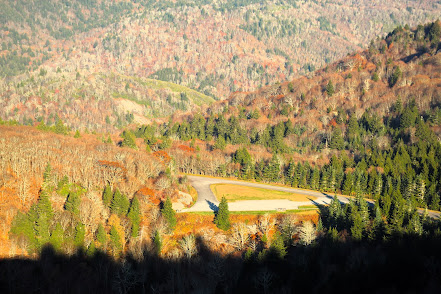There are many deserted towns in Western North Carolina. Some were abandoned when their land was taken over to form Great Smoky Mountain National Park and others lie partially or totally beneath lakes that were created to produce hydroelectric power. The town of Lost Cove just faded away mostly because of the remoteness and isolation of it's location. It lays on a plateau beneath the summit and accompanying ridge of Flattop Mountain and a large bend in the Nolichucky River which forms a gorge through this area. It has since become a Mecca for area hikers (but be forewarned it is not suited to novices). A gray, chill early autumn day seemed just right to venture down into this ghost town.
The trail down into Lost Cove is likely one that served as one of their lifelines to the outside world. There were never any developed roads to the outside nor was there telephone service. Histories talk about trips to the nearest town of Poplar which involved dragging a sled 2 1/2 miles to trade goods and pick up mail at the general store. A railroad was built through the Nolichucky gorge between 1890 to 1910 that had a stop for Lost Cove (only a one mile hike). This provided greater access bringing manufactured goods, economic vitality with lumber exports and an influx of a few new families. However, the discontinuation of passenger service a couple decades later was a factor in the decline of the town.
There are popular stories that the first to settle in the cove were members of Daniel Boone's party but there is no documentation of this. The first known settler was a union soldier named Stephen "Morgan" Bailey during the civil war era who traded his shotgun and ten dollars for land there. (Morgan's father ceded land in 1834 that became nearby Burnsville, NC). The Bryants, Millers and Tiptons were also early families in the community.
Lost Cove through the early part of the 1900s were a mostly self-sufficient farming community. Homes were fashioned from logs and creek rocks. The families took care of each other, swapping extra crops and labor. Some of what they grew, foraged or produced was trudged to the trading post in Poplar to get essentials such as lamp oil they required. One of the products residents were known for was moonshine (though an oral history differentiates they made corn liquor--that moonshine had sweeteners). While illicit stills were prevalent in Appalachia, the location of Lost Cove made it a haven for the trade. The isolation of the cove meant that revenue agents were less motivated to visit. Additionally, the land was a disputed territory. The boundary line between North Carolina and Tennessee was not definitively established and so there were questions of jurisdiction when cases did come to court.
With the coming of the railroad and the first sawmill in the early 1900s, a new economy arrived for the residents. The saw mill on Devil's Creek provided employment and income directly and indirectly to all the inhabitants. That came to a halt in 1925 when a large fire wiped out the sawmill and the land being forested. The town was spared but impoverished. A second sawmill was constructed in 1939 and was the last building constructed in Lost Cove. One of the iconic relics of the town is the remains of Swin Miller's 1938 Chevy pickup. It was brought to Lost Cove on a railroad flat car to haul lumber from the sawmill to the railroad.
The early self-sufficiency that had marked the settlement had transformed into an interconnectedness with the modernizing outside world. These forces eventually spelled doom for the community. The forests became logged out and the lumber industry vanished. The railway began bypassing Lost Cove. One of the hearts of Lost Cove had been the church (free will Baptist) and school which shared the same building (stairs pictured above). In the early 1950s Yancy County was consolidating their school system and decided that the students in Lost Cove could no longer spend their entire education career in the one room schoolhouse. High School students were forced to go to a regional school. That meant the students had to hike out on Sunday afternoon and return on Fridays after school. They would be boarded during the week. A paved road was proposed but never followed through with. Families moved away for employment opportunities and some young men enlisted in the Korean War.
On December 26, 1957, Velmer and Servilla Bailey and their four children--the final family remaining in Lost Cove--departed. The above is one of two house that are still standing (though the other one is rapidly being taken down by nature). By looking at old photos and oral record, I believe this to be the home of Chester Bailey. In 2007 a fire destroyed many of the homes in Lost Cove. Home sites are distinguished by walls, some chimneys, metal artifacts such as bed frames, and sheet metal from roofs.
My final stop in exploring the defunct town was the cemetery. Ironically, it is always visits to the family cemeteries in the mountains that bring life to the people who lived there. The cemetery there is a mixture from small creek stones markers to elaborately engraved marble headstones. Many of the stones that appear to have had inscriptions have weathered so much their message is lost to time.
For much of the information in this post I am indebted to a thesis done by Christy A. Smith at ETSU. She did a remarkable job researching and interviewing past residents whose oral records are now preserved. If you want to really learn about what life was like for these people, I encourage you to read her work at: https://dc.etsu.edu/cgi/viewcontent.cgi?article=3508&context=etd
















No comments:
Post a Comment